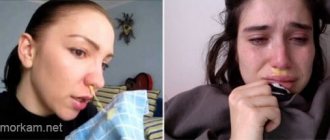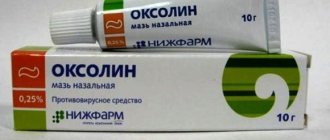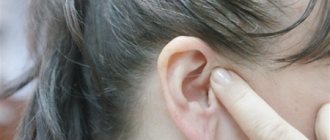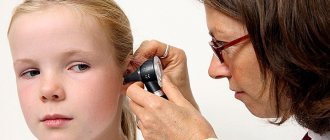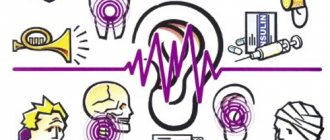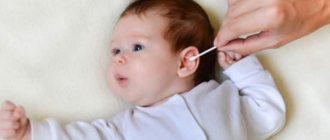It is important for every parent that their child is healthy. But we all understand that it is impossible to completely avoid diseases. There is always a chance that he will catch ARVI at least once in his life.
It seems that everyone knows the main symptoms of colds and viral diseases. Most often it is a cough, runny nose and fever. But what to do if the baby has no fever, no cough, but his nose is stuffy and can’t breathe at all? There can be several reasons for nasal congestion. Let's figure out why it can happen that a child has a stuffy nose, but has no snot.
Rhinitis
One of the most common causes of nasal congestion is rhinitis. This is an upper respiratory tract disease. It is provoked by hypothermia, especially in children with reduced immunity.
Rhinitis can be allergic and infectious. Most often, infectious rhinitis occurs in children, since children communicate with each other quite closely, play in the same sandbox, with the same toys, go to the same kindergarten, etc.
Rhinitis develops rapidly. First, a stuffy nose is observed, and after a few hours a runny nose, lacrimation and increased body temperature appear.
Allergic rhinitis has similar symptoms, but you won't be able to treat it until you identify the allergen. Eliminating the irritant is the best treatment, and no other medications are simply needed. Therefore, if a child’s nose is not breathing, but there is no snot and no other symptoms are observed, then be sure to consult an allergist.
If you suspect your baby has allergic rhinitis, then try to remember what’s new in your baby’s life. Perhaps the child began to come into contact with animals. Perhaps it’s spring outside and all the plants are in bloom. Or you changed the washing powder. Tell your local pediatrician about any assumptions.
Treating yourself at home
- It is very good to carry out inhalations. They can be done with saline solution, mineral water. A folk recipe suggests inhalation with steam from boiled potatoes: cover yourself with a blanket for 5–10 minutes and breathe over the steam.
- Rinsing the nose with saline solution can also have a good effect. In both cases, dried mucus softens in the nasal sinuses, which prevents free breathing, and it is easier to remove. Plus, using these methods you can not only treat congestion without snot, but also prevent inflammation of the sinuses.
- Nasal congestion will go away quite quickly if you do a light massage: at first, lightly rub the wings of the nose and the bridge of the nose in a circular motion, and when the skin in these places becomes warm, lightly tap for about ten minutes.
- If you regularly instill freshly squeezed Kalanchoe juice, you can ensure that the ailment goes away in a couple of days. They also treat sinusitis, there are no contraindications.
- A solution of sea salt in water relieves swelling well. Place a drop of iodine in a glass of water, dilute a pinch of salt and instill it for several days: first one nostril is treated, then the other. This is how chronic sinusitis is relieved.
- Traditional medicine recommends treating congestion using herbal lotions. To do this, boil a mixture of linden flowers, chamomile and St. John's wort (a teaspoon) for 20 minutes. Soak a gauze swab in this broth and insert it alternately into the nostrils for 5 minutes.
- Warming the nose on both sides in the area of the maxillary sinuses (if there is no pus!) with boiled, non-hot eggs also helps to relieve swelling. This procedure should be done for 10 days for 10–15 minutes, preferably before bed, to eliminate the causes of nasal congestion and cure chronic sinusitis.
Read What to do when a child has a stuffy nose
Individual features of the structure of the nasal septum
The baby may have a congenital defect in the form of a deviated nasal septum. It cannot always be detected immediately. Often the defect appears as the baby grows older. It can progress for years, preventing the child from breathing fully.
If the baby has no signs of a cold, and the nose is constantly stuffy, the child breathes through his mouth, then take him to an otolaryngologist. When a person with a deviated nasal septum develops a runny nose, he is completely deprived of the sense of smell and the ability to breathe at least a little through his nose. Since he does not breathe through his nose at all, the mucous membranes dry out, which leads to greater susceptibility to infections, as well as snoring.
A deviated nasal septum can only be treated with surgery. And it is completely justified if your nose is constantly stuffy. The operation is called septoplasty. Until the age of 18, this procedure is done only as a last resort. The operation itself takes place under general anesthesia and consists of giving the correct shape to the nasal septum.
The operation has a fairly painful recovery period. The ability to breathe freely through your nose will appear after 3–4 weeks. An indication for such an operation in a child may be constant exacerbations of chronic rhinitis and sinusitis.
Polyps
The appearance of polyps is also manifested by nasal congestion and lack of runny nose. Polyps appear without snot in the child, and a decreased sense of smell may be noted.
Polyps are an increase in the volume of the nasal mucosa. Against the background of constant infectious or allergic reactions, the nasal mucosa expands, trying to prevent the entry of harmful bacteria. This process can take several years. The mucous membrane clogs the nasal passages quite slowly. Often it is not one polyp, but many. They can be located along the entire perimeter of the nasal mucosa. If a child is diagnosed with polyps, they are removed through surgery.
Adenoids
This disease most often affects children of preschool and primary school age. Adenoids are formed when the tonsils in the nasopharynx become inflamed. This is often associated with a large number of infectious diseases.
Adenoids are also removed surgically, but in the early stages they can be treated with medication. The operation is performed under local anesthesia, of course, causing a lot of stress for the child.
Therefore, it is much better to prevent the appearance of adenoids in your baby. Carefully monitor your child’s health and protect from frequent infections. If your baby often catches colds and feels unwell, then regular visits to physiotherapy and hardening will provide a good healing effect.
The child does not breathe through his nose: causes and consequences, advice to parents
What is the purpose of breathing through the mouth?
This phenomenon is most common in preschool children. A child in kindergarten begins to suffer more often from illnesses accompanied by a runny nose. In this regard, mouth breathing
may become habitual.
Babies also often breathe through their mouths.
.
Some people even consider this to be the norm, since babies have not yet learned to breathe properly. Although babies usually breathe through their mouths if nasal breathing
is difficult. Let's say the baby fell ill with a viral disease, due to which it turned out to have a stuffy nose.
However, during feeding, it becomes extremely uncomfortable for her to breathe through her mouth. Another reason why a child may prefer mouth breathing
the nasal recognizes the incorrect position of the head in the crib. The situation can be easily corrected by placing a pillow on her.
What diseases make breathing through the nose difficult?
- — Adenoids
The child breathes through his mouth at night, and during the day, as expected, through his nose. This is a typical phenomenon for all young children who have suffered a similar disease. As a rule, the situation normalizes a few days after the runny nose disappears.
Some babies are predisposed to enlarged adenoids
.
They complicate the processes of breathing and blood circulation. This can lead to persistent runny nose and sinusitis. Sinusitis
and enlarged adenoids require treatment by a doctor. Sometimes the adenoids are removed surgically. This is done in cases where the child loses the ability to breathe normally. Other negative consequences of this disease include hearing loss, nervous disorders, and improper development of the facial structure.
- — Deviated nasal septum
Usually the cause of curvature is improper growth of the facial skull or injury. Due to such deformation, breathing difficulties, disruptions in the functioning of the nervous system, and headaches are often observed. In addition, the shape of the nose often changes, a predisposition to allergic reactions appears, and deviations in the functioning of the genitourinary or circulatory system are observed.
Most often, problems with a deviated septum occur in adolescence, and 3 times more often in men. This disorder is corrected surgically.
- — Allergic rhinitis
Due to allergies, the baby often experiences nasal congestion and swelling
.
He has mucous discharge, so initially you might think that the baby has a runny nose
. Thus, due to swelling of the mucous membrane, she has to breathe through her mouth.
The peak occurrence of such a disease occurs in spring and summer (for example, during the flowering period of vegetation). Sometimes it takes a chronic form. Among other allergy warning signs, we note:
- - sneezing,
- - redness of the eyes,
- - snoring,
- - breathing through the mouth,
- - itching in the nose, throat and hard palate area,
- - deterioration of sense of smell.
A doctor will help you correctly identify this disease.
- — Polyps
Polyps
- these are special formations of the mucous membrane that appear during its growth. To a greater extent, they are characteristic of adults, not children. The development of polyps can be provoked by allergic diseases and infectious diseases (frontal sinusitis, sinusitis and ethmoiditis).
Detect the beginning of polyp growth
not easy, since the main symptom is difficulty breathing. The child becomes stronger and is susceptible to colds and viral diseases.
Polyps
eliminated traditionally and surgically. Through surgical intervention it will be possible to get rid of the formations that have arisen, but the reason for their appearance remains unresolved. In this regard, a relapse is quite likely in a year or a year and a half.
- — Sinusitis
This is the name given to a number of inflammatory diseases of the sinuses
.
They also appear in small children. Acute sinusitis
occurs in children one and a half to two years old, ethmoiditis is also observed in smaller children, frontal sinusitis appears in children five years old, and
sphenoiditis
most often affects children from ten years of age.
Enlarged adenoids
increase the likelihood of developing the above diseases.
In addition, they prevent the outflow of fluid from the sinuses. Another very common cause of their occurrence is bacterial infection
.
Children have sinusitis
It is not very easy to identify, because the symptoms characteristic of these diseases are not as noticeable as in adults. Redness of the mucous membrane can easily be confused with a runny nose.
A child suffering from sinusitis may have a fever, poor appetite, cough, as well as fatigue and bad breath.
What are the consequences?
Let us mention among them:
- — the supply of oxygen to the body is reduced by about a quarter, as a result of which the baby becomes somewhat absent-minded;
- — the nasal passages narrow, which is a consequence of the proliferation of adenoids;
- - the perioral muscles become weaker, and this affects the baby’s speech development (the pronunciation of hissing letters and the letter “P” is impaired, the timbre of the voice changes, and nasal sound is noted);
- - an incorrect bite is formed, since the tongue is positioned incorrectly and deformation of the upper palate occurs;
- - mouth breathing in a baby can continue at night, as a result of which her sleep becomes restless;
- - when air enters through the mouth, microbes and viruses bypass the unique protective barrier located in the nose, so ailments such as laryngitis, sore throat and bronchitis can develop;
- - the baby loses his appetite, his sense of smell becomes worse;
- - headaches occur;
- - posture worsens, because the baby often tilts his head forward to swallow saliva.
How to retrain him?
This is quite difficult to do. However, breaking any habit is not easy. Effective tools for retraining are: special breathing exercises or special medical items.
Among them we can mention a silicone plate. It is placed in the baby's mouth for a while. This allows you to correct the position of the tongue, palate and helps you get used to proper breathing
. Most children manage to return to nasal breathing thanks to such events.
Foreign object
If the baby’s nose is stuffy and the snot is not flowing, then parents should be wary. One of the causes of a stuffy nose can be a foreign object in the nasal passage. This often happens to young children. Be careful when your child plays with small objects.
If your nose is suddenly stuffy, but there is no snot, and you suspect that your baby has put something in his nose, then immediately contact a pediatric surgeon. Do not try to get the item yourself, trust a professional. It is also worth consulting a doctor if your child snores.
Causes
Many parents themselves have repeatedly experienced discomfort in cases where the nose does not breathe, the head hurts and overall health leaves much to be desired.
In children, this is further aggravated by the fact that not all of them, due to their age, can explain what is bothering them. Parents need to be very attentive to situations when a child has a stuffy nose, but without snot, and this has been going on for quite a long time. Several options why children may have congestion without a runny nose:
- Injuries, pathologies. Perhaps the nasal septum has peculiarities, curvatures, due to which the passages narrow and the mucus is not rejected.
- Adenoid growths resulting from infectious diseases (influenza, measles, scarlet fever and others).
- Overgrown polyps in the nose, as a result of which the passages narrow, breathing is difficult and snot does not flow out.
- Foreign bodies stuck in the nasal cavity.
- An allergic reaction that caused the development of inflammation and swelling.
Colds
If a child sniffles, but there is no snot, most likely he has a cold, ARVI or flu. The body reacts to infection and mucus forms. If it clears normally, the runny nose goes away within a week, but retention of mass in the nasopharynx and difficulty breathing indicate the presence of pathology.
If the disease is complicated by a bacterial infection, there is a risk of developing inflammation of the sinuses - sinusitis. In this case, the discharge becomes purulent and it becomes increasingly difficult to breathe.
Features of a stuffy nose in infants
During the first few months of life, children may experience difficulty breathing through the nose, the so-called false rhinitis of the newborn. The fact is that in an infant, the nasal mucosa is formed up to six months. Mucus in the nose is produced in large quantities. If the room is too hot and dry, it turns into crusts, and the child has trouble breathing through his nose. And children learn to breathe through their mouth only at 3–4 months.
To prevent the mucus from drying out in the baby’s nose and for him to breathe calmly, rinse the baby’s nose daily with sea water or regular saline.
This will make the snot more liquid, and it will flow into the child’s mouth. He will swallow them. Don't worry, it's completely safe.
You can prepare your own nasal rinse solution. Take 1 liter of boiled water and a tablespoon of sea salt, mix everything thoroughly. It is better not to use regular table salt, since its content of useful minerals and trace elements is much lower.
If you have chronic nasal congestion without a runny nose
- If an adult has a constant runny nose and nasal congestion, but there is no allergy and therefore this is not the result of an allergic reaction, care must be taken to moisturize the nasal passages and sinuses both outside and inside. The easiest way is to wipe your nose with a heated, damp cloth several times throughout the day.
- If the air in the apartment is dry, you should try to humidify it as much as possible. You can put an open pan of hot water in the room and hang wet towels. It is best to buy a humidifier.
- When going to bed or just lying in bed, it makes sense to put your head higher - this also makes breathing easier during sleep and helps remove mucus.
- Bring your diet back to normal. It is better to replace refined sugar with natural sugar. You can use sweeteners that do not contain calories.
Read Effective treatment and prevention of persistent runny nose in a child
Useful tips
- It so happens that the absence of visible causes for a runny nose confuses parents. Your child may actually have a runny nose. The discharge cannot flow out because it is too thick. This happens due to dehydration of the body. The more water a child drinks, the less thick the blood and other fluids will be.
Cool, moist air also helps thin mucus. The easiest way to achieve this indoors is with a humidifier. The ideal temperature in a child’s room is 19–20 ºС, humidity is 70%.
- To moisturize the nasal mucosa and prevent diseases, rinsing the sinuses is good. If the child has not yet reached 1 year, then drip a solution of sea salt into the baby’s nose. This will prevent the mucus from thickening and making breathing difficult. For children over 3 years of age, a nasal spray with sea water can be used. Of course, children do not like such procedures, but they are necessary.
- Rinsing your nose also helps with nasal congestion. To do this, you need to pour a saline solution into each nostril from an aspirator or syringe without a needle. At the initial stage of a runny nose, this procedure should be carried out several times a day.
- Use hot foot baths with caution and after consulting a doctor. Firstly, too warm water is dangerous for a child, as it causes a sharp dilation of blood vessels. Secondly, a sudden liquefaction of mucus can lead to a severe coughing attack that is difficult to stop without medical help.
It is very important to promptly treat nasal congestion, especially in children. Neglect of this problem can lead to the disease becoming chronic, most of which can only be treated surgically. In earlier stages, physical therapy may help. Make sure that the child under no circumstances uses vasoconstrictor drops and sprays uncontrollably. Do not neglect the help of a doctor. It is he who will be able to prescribe appropriate treatment in time to prevent complications from occurring.
What to do and how to treat nasal congestion
Before starting treatment, you should create conditions under which it becomes easier to breathe at work and at home. In this situation it is recommended:
- ventilation of the room;
- air humidification;
- eating spicy food;
- sleeping with your head held high;
- drink a lot;
- inhalation;
- inhalation of wet steam;
- rinsing the nose with special solutions;
- warming up;
- drinking hot liquids.
How to relieve nasal congestion? Treatment involves the use of medications according to the cause of the disease. To alleviate the condition, a precise massage of the wings of the nose and bridge of the nose is used. Yoga classes, breathing exercises, and physiotherapy give good results. There are many traditional medicine recipes that improve the condition and moisturize the mucous membrane. Complex cases require surgery, laser and cryotechnology.
Drug therapy
It is necessary to begin treatment of congestion in time to avoid complications on the organs of hearing and throat, since everything is interconnected. To get a positive effect, you must follow the doctor's prescriptions and instructions for use. Medicines used for treatment:
- Sprays and drops: “Tizin”, “Rinorus”, “DlyaNos”.
- Ointments: “Doctor Mom”, “Evamenol”, “Fleming Ointment”.
- Tablets for relieving edema "Clarinase-12".
- Anti-allergy tablets: Loratadine, Zodak.
- How to restore hair after bleaching
- Shortbread pie with apples - how to cook, photos and videos. Recipes for delicious shortbread pie
- Mucaltin - what cough to take. Treatment of all types of cough with Mucaltin tablets - instructions for use
The use of specific drugs is associated with the causes of the disease:
- In case of congestion due to viruses, local antibiotics are prescribed in the form of drops and sprays: Amoxicillin, Bioparox. Common drugs include Erythromycin and Clarithomycin. Antibiotics should be taken strictly as prescribed by your doctor.
- If the cause of congestion is immunodeficiency, take herbal immunostimulants: echinacea, ginseng root.
Of particular note is the use of inhalations for the treatment of reducing swelling and nasal congestion. The use of a nebulizer allows you to deliver fine particles of medication deep to the diseased organ. Decoctions of chamomile, thyme, eucalyptus, and calendula are used as medicinal products. Among the medicinal preparations, Xylometazoline and the local antibiotic Polidex are used.
Surgical intervention
For special indications, when there is no runny nose, but the nose is not breathing, surgical operations are prescribed. They are performed without anesthesia using a laser radio wave method. There are methods using cryotechnology, when the problem area is burned out by cold. They cannot do without traditional operations. Surgery is prescribed for:
- presence of a foreign body;
- proliferation of mucous tissue;
- the presence of polyps, adenoids;
- curvature of the nasal septum.
Folk remedies for treatment at home
It is difficult to ignore the use of folk remedies. Inhalation over boiled potatoes has been familiar since childhood. Inhaling vapors with Golden Star balm and eucalyptus oil also improves the condition. Effectively rinsing the nose with sea salt: a large spoon per 200 g of water. Distraction therapy works well for congestion:
- tea with raspberries and linden;
- hot foot baths;
- socks with dry mustard;
- hot shower;
- mustard plasters on calves.
Instillation into the nose gives good results. It is recommended to use it every 4 hours. Use homemade drops:
- carrot juice half and half with water;
- drops from Kalanchoe;
- onion juice in equal parts with water;
- aloe drops;
- sea buckthorn oil and carrot juice in proportions 1:1;
- A glass of water requires a drop of iodine and a pinch of sea salt;
- in equal parts beet juice and onion juice.
For children it is recommended to use folk recipes:
- instillation of mother's milk in infants;
- infants breathing over the steam of a hot bath;
- warming the nose with a boiled egg;
- lubricating the nose with onion oil: pour onion juice with hot vegetable oil and leave overnight;
- rinsing the nose with a salt solution: a tablespoon per glass of water;
- instilling aloe juice in equal parts with water.
